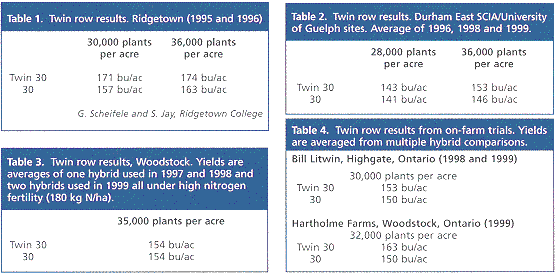
Twin Row Corn
Interest in narrow row corn and
more recently, twin row corn has been intense over the past decade. But research
results indicate sharp pencils are still required when considering changes.
By the mid 1990s, research conducted in various locations across the northern
Corn Belt and southern Ontario was indicating significant yield advantages
could be expected from narrowing corn rows from traditional 30 - 38 inches
down to row widths that ranged from 15 - 24 inches. Results showed that narrow
row advantages would be greater in more northerly latitudes, compared to results
coming out of the mid to southern portions of the Corn Belt. Ontario producers
who converted to narrow row production systems at this time did so, for the
most part, by converting to 20-inch rows and anticipated paying for planter
and corn header conversions with an expected yield boost of three to eight
per cent.
Starting in 1995, twin row configurations (two rows generally seven or 7.5
inches apart but still centered on 30 inches) were introduced into research
projects. Gordon Sheifele's work out of Ridgetown College showed that the
twin row concept could deliver yield increases over 30-inch single rows (Table
1) and in some cases were equivalent to those obtained with single narrow
rows 15 or 20 inches apart. Work done by Durham East Soil and Crop Improvement
Association in conjunction with the University of Guelph began in 1996; results
from that year showed significant yield gains for twin 30-inch rows over other
row configurations (providing plant populations were increased as well). This
particular study has continued for the past several years and results have
indicated less yield advantage for twin rows than in that first year (see
Table 2).

Further studies have also been ongoing
at Woodstock (University of Guelph) and Ottawa (Agriculture and Agri-Food
Canada) to evaluate corn response to narrow rows. These studies have included
various nitrogen rates and physiological measurements to try and sort out
the basis for narrow row response. The yield results from the Woodstock site
have indicated absolutely no yield difference between the twin and single
rows (Table 3). Similar patterns
have been observed at the Ottawa site (data not shown).
Recently, numerous on-farm trials have been conducted to examine twin row
corn on a field scale basis. Trials from Bill Litwin and Hartholme Farms are
reported in Table 4. These tests have examined numerous hybrids and have shown
yield advantages for twin rows with some hybrids more than others. Reasons
for differential response among hybrids is still unclear. Pioneer research
has generally indicated all of the hybrids the company has tested in Ontario
have responded similarly to narrow row configurations.
In general, the yield advantages to twin row corn have been inconsistent across
the various years and locations where trials were conducted. One of the main
advantages to twin row corn has been the cost savings from not having to make
any modifications to the corn header or tractor tire spacing. Some of these
savings are perhaps offset by additional wear on the corn header, as it is
continually required to pull corn stalks and operate at lower harvest speeds.
When considering twin row corn, it appears corn yield increases over traditional
30-inch corn may not always be adequate to justify equipment and management
changes. Those operators most likely to enhance net profitability will be
those who can combine the changes in corn planter configuration to mesh with
soy or edible bean planting systems and make one piece of equipment do for
all crops.